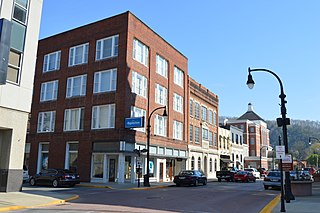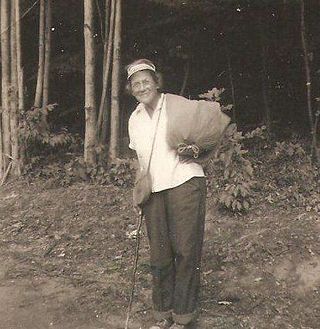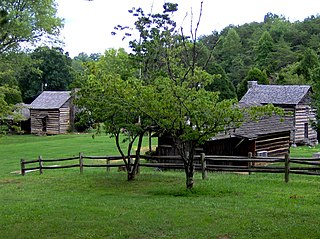
Huntington is a city in Cabell and Wayne counties in the U.S. state of West Virginia. The county seat of Cabell County, the city is located at the confluence of the Ohio and Guyandotte rivers. Huntington is the second-largest city in West Virginia, with a population of 46,842 as of the 2020 census. Its metro area, the Huntington–Ashland metropolitan area, is the largest in West Virginia, spanning seven counties across three states and having a population of 376,155 at the 2020 census. During the 1900s, the city was a major hub for manufacturing, transportation, and Industrialization. After World War II, due to the shutdown of these industries, the city lost nearly 46% of its population, from a peak of 86,353 in 1950 to 54,844 in 1990. Both the city and metropolitan area declined in population from the 2010 census, a trend that has been ongoing for six decades. It is home to the Port of Huntington Tri-State, the second-busiest inland port in the United States.

Pikeville is a home rule-class city in and the county seat of Pike County, Kentucky, United States. The population of Pikeville was 7,754 as of the 2020 U.S. Census. Pikeville serves as a regional economic, educational and entertainment hub for the surrounding areas of eastern Kentucky, Virginia and West Virginia. It is home to the University of Pikeville and the Pikeville Cut-Through, the second-largest earthmoving project in the western hemisphere.

The Hatfield–McCoy feud, also described by journalists as the Morris-Moran conflict, involved two American families of the West Virginia–Kentucky area along the Tug Fork of the Big Sandy River from 1863 to 1891. The Hatfields of West Virginia were led by William Anderson "Devil Anse" Hatfield, while the McCoys of Kentucky were under the leadership of Randolph "Ole Ran'l" McCoy. Those involved in the feud were descended from Joseph Hatfield and William McCoy (born c. 1750). The feud has entered the American folklore lexicon as a metonym for any bitterly feuding rival parties.

A log cabin is a small log house, especially a less finished or less architecturally sophisticated structure. Log cabins have an ancient history in Europe, and in America are often associated with first-generation home building by settlers.

Emma Rowena (Caldwell) Gatewood, known as Grandma Gatewood,, was an American ultra-light hiking pioneer. After a difficult life as a farm wife, mother of eleven children, and survivor of domestic violence, she became famous as the first solo female thru-hiker of the 2,168-mile (3,489 km) Appalachian Trail (A.T.) in 1955 at the age of 67. She subsequently became the first person to hike the A.T. three times, after completing a second thru-hike two years later, followed by a section-hike in 1964. In the meantime, she hiked 2,000 miles (3,200 km) of the Oregon Trail in 1959. In her later years, she continued to travel and hike, and worked on a section of what would become the Buckeye Trail. The media coverage surrounding her feats was credited for generating interest in maintaining the A.T. and in hiking generally. Among many other honors, she was posthumously inducted into the Appalachian Trail Hall of Fame in 2012.

Silver Dollar City is a 61-acre (25 ha) amusement park in Stone County, Missouri, near the cities of Branson and Branson West. The park is located off of Missouri Route 76 on the Indian Point peninsula of Table Rock Lake. Silver Dollar City opened on May 1, 1960. The park is an 1880s-themed experience. Silver Dollar City's operating season runs from March until December, with the park closed for two months. Silver Dollar City is owned by Herschend Family Entertainment.

The economy of West Virginia nominally would be the 62nd largest economy globally behind Iraq and ahead of Croatia according to 2009 World Bank projections, and the 64th largest behind Iraq and ahead of Libya according to 2009 International Monetary Fund projections. The state has a projected nominal GDP of $63.34 billion in 2009 according to the Bureau of Economic Analysis report of November 2010, and a real GDP of $55.04 billion. The real GDP growth of the state in 2009 of .7% was the 7th best in the country. West Virginia's economy accelerated in 2014 with a growth rate of 5.1%, ranking third among the fastest growing states in the United States alongside Wyoming and just behind North Dakota and Texas. In 2021, the state GDP was $72.48 billion, an increase over $69.71 billion in 2021.
Melvin Wine was an American Appalachian fiddler from the state of West Virginia. He was a lifelong resident of Copen, in Braxton County, West Virginia.

The Museum of Appalachia, located in Norris, Tennessee, 20 miles (32 km) north of Knoxville, is a living history museum that interprets the pioneer and early 20th-century period of the Southern Appalachian region of the United States. Recently named an Affiliate of the Smithsonian Institution, the museum is a collection of more than 30 historic buildings rescued from neglect and decay and gathered onto 63 acres (25 ha) of picturesque pastures and fields. The museum also preserves and displays thousands of authentic relics, maintains one of the nation's largest folk art collections, and hosts performances of traditional Appalachian music and annual demonstrations by hundreds of regional craftsmen.

Camden Park is a twenty-six acre amusement park located near Huntington, West Virginia. Established in 1903 as a picnic spot by the Camden Interstate Railway Company, it is one of only thirteen trolley parks that remain open in the United States. Whereas most trolley parks were located at the end of trolley lines, Camden Park is unusual in that it was built where riders traveling between Huntington and nearby cities would stop to change lines. Not long after opening, the park soon gained a carousel and other roadside attractions. Camden Park is West Virginia's only amusement park. The park is home to more than thirty rides and attractions, including a full-size traditional wooden roller coaster, the Big Dipper, and several other vintage rides.

Marble Springs, also known as the Gov. John Sevier Home, is a state historic site in south Knox County, Tennessee, in the southeastern United States. The site was the home of John Sevier (1745–1815)—a Revolutionary War and frontier militia commander and later the first governor of Tennessee—from 1790 until his death in 1815. A cabin at the site was once believed to have been Sevier's cabin, although recent dendrochronological analyses place the cabin's construction date in the 1830s, well after Sevier had died.

The dogtrot, also known as a breezeway house, dog-run, or possum-trot, is a style of house that was common throughout the Southeastern United States during the 19th and early 20th centuries. Some theories place its origins in the southern Appalachian Mountains. Some scholars believe the style developed in the post-Revolution frontiers of Kentucky and Tennessee. Others note its presence in the South Carolina Lowcountry from an early period. The main style point was a large breezeway through the center of the house to cool occupants in the hot southern climate.

Hatfields & McCoys is a 2012 American three-part Western television miniseries based on the Hatfield–McCoy feud produced by History channel. The two-hour episodes aired on May 28, 29, and 30, 2012.

The Saxon Lutheran Memorial in Frohna, Missouri, commemorates the German Lutheran migration of 1838–1839, and features a number of log cabins and artifacts from that era. The memorial opened in 1962 and was placed on the National Register of Historic Places in 1980.

Barnwood Builders is an American documentary television series following a team of builders that remove logs and beams from old cabins and historic barns to use them when constructing modern houses. Originally produced for the DIY Network, by season 15, the series had been taken over by Magnolia Network which replaced the DIY Network and, is broadcast on Magnolia and on fuboTV. The series is produced by Silent Crow Arts. The show was in the 16th season as of 2023.

The Bill Monroe Farm is a historic farm attributed to being the birthplace of Bill Monroe, creator of the bluegrass music genre. The farm is 1,000 acres (4.0 km²) and is located near Rosine in Ohio County, Kentucky. It was listed on the National Register of Historic Places in 2003.
The Spruce Forest Artisan Village is an arts and heritage center in Garrett County, Maryland, that is dedicated to preserving the heritage of the region. Resident and visiting artisans demonstrate their crafts in restored log cabins and vintage frame structures. Artisan crafts include blacksmithing, weaving, wheel-thrown pottery, bird sculpting, woodturning, and jewelry-smithing. There are living history programs and several historic house museums, including the House of Yoder. Approximately 60,000 people visit the village each year.















































